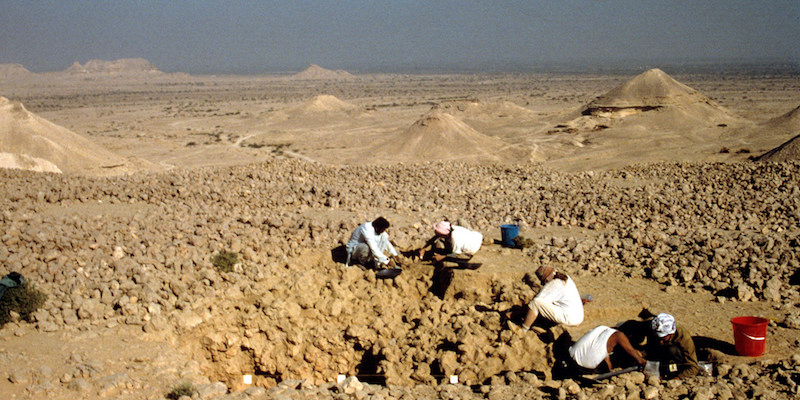“Can you see that spot in the distance? Well, that's where I dig,”Paolo Biagi says as he indicates a dark spot that looks like an anomaly in the flat limestone terraces that extend along the eastern side of the Indus Valley. The first time Biagi climbed the cliff that took him to the top of these mesas in 1985, he understood that human interference had undoubtedly reshaped them. He went on to find the first chert mines of Upper Sindh, a region that is, at present, a province of Pakistan. See the location on the map.
“No archaeologist had ever ventured on those terraces before us”, says the Professor in Prehistory and Protohistory at the Department of Asian and North African Studies, “Everyone was interested in the great Bronze Age cities of the Indus Valley, while my research project took me elsewhere to discover, for example, how important chert was in the economy of the Indus Civilization, something that reached its maximum expansion and development some 4500 years ago.”
These discoveries have allowed us to understand that this was the largest and richest chert mining area in the Indian Subcontinent. Four years of excavations have revealed just a fragment of new data on the exploitation of this important resource: how it was extracted, the social classes and workers involved in its exploitation, the selection process as well as the routes of its spread and trade, by both river and land, towards the great cities of the Indus world. Gallery
Boasting thirty years of archaeological work in Pakistan, Biagi is one of the most noteworthy scholars in the region. The Shah Abdul Latif University of Khairpur awarded him a gold medal in 1999 for his work in the Rohri Hills chert mines. His latest award was given to him by the Shaheed Benazir Bhutto Women University of Peshawar where Biagi was recently nominated visiting professor.
Pakistan is a flourishing country and Italy is its third partner in terms of commercial ties after the United Kingdom and Germany. In this context, universities here are opened and develop with an eye towards collaborations with other universities worldwide. The Benazir Bhutto Women University of Peshawar is planning to open a Department of Archaeology and is counting on the support of Ca’ Foscari for both teaching and research. Furthermore, Ca’ Foscari has just signed an agreement with the Quaid-i-Azam University of Islamabad for exchanging students and teaching staff.
“Pakistan needs help to form a new class of archaeologist,” Biagi explains, “Italy holds a privileged position in the area thanks to an interest born at the beginning of the 1900’s with the Duca degli Abruzzi, and cultivated by distinguished scholars like Professors Giuseppe Tucci and Paolo Graziosi. Islamabad holds a number of promising students from all over the country. Three Pakistani archaeologists have already completed their studies at Ca’ Foscari. Professor Ghani ur Rahman, one of our former PhD students, has recently been appointed director of the Taxila Institute of Asian Civilizations at Quaid-i-Azam University, Islamabad. Ca' Foscari is, therefore, at the forefront in representing Italian universities in the region, educating scholars and developing archaeological thought in the country.”
What else can archaeology reveal in Pakistan? “There’s so much work to do,” Paolo Biagi answers, “Both in the northern Gandhara territories where Alexander the Great positioned himself for a number of years, and in the southern regions of the country.” In fact, in recent years the team led by Biagi has centred its efforts first in Lower Sindh and then in the province of Las Bela, Balochistan, in the south.
All around Lake Siranda, the Ca’ Foscari expedition has discovered more than seventy prehistoric sites, mainly shell middens. Information gathered there has allowed scholars to formulate new hypotheses on the past environment and the sea-level variations that took place along the northern coast of the Arabian Sea since the beginning of the Holocene. The lake, at present isolated and seasonally fed by monsoon rains, was, up to 5000 years ago, an elongated, shallow gulf of the ocean. It is the view of archaeologists that Alexander the Great probably camped along the banks of Siranda Lake during his difficult retreat towards Babylon.
Archaeological work is not only a scientific challenge but a cultural challenge as well. Many promising sites and others already unearthed have been damaged or destroyed by human development. “Unfortunately, our results and the dozens of articles that have been written have not brought about the conservation of the sites,” Biagi informs us, “even though the laws provide for their safeguard. One example is the Rohri Hills and other mesas that are exploited for quarrying limestone irrespective of the unique presence archaeological sites all over the region. Sites in the subcontinent area are destroyed, above all, by industrial and commercial activities and urban development. These activities have systematically devastated more archaeological heritage than any military operation.”











